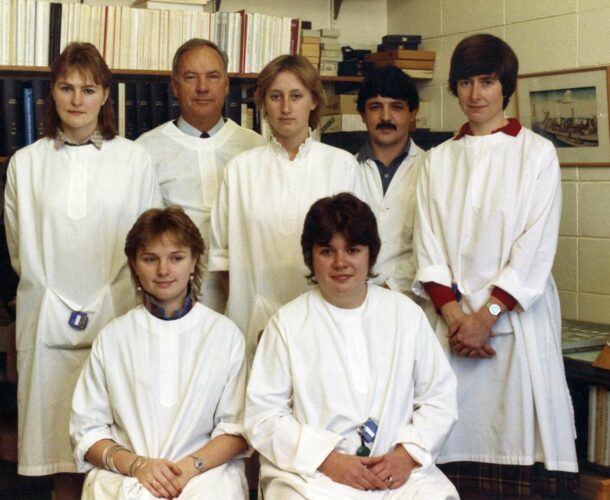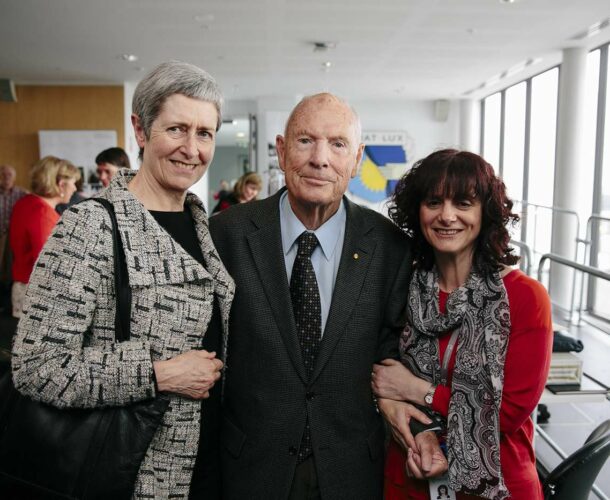Dr Anne Kelso joins Don Metcalf’s team researching CSFs at a critical period; the team is trying to clone one of the CSFs so they can make it in high enough amounts so that it might be able to be used for clinical trials.
Kelso’s expertise with T cells and their behaviour assists in a significant milestone cloning of the first recombinant CSF – GM-CSF – which leads to preclinical testing of the effectiveness of CSFs in boosting white blood cells.
Catalyst for research
Perhaps a life in science was inevitable for Anne Kelso. Her father was a Geelong doctor, and her mother had studied botany at the University of Melbourne. Nonetheless she nominates a book she read as an impressionable teen as the catalyst for what would become a remarkable career as a medical researcher and scientific leader.
The book was Professor Macfarlane Burnet’s 1968 autobiography, Changing Patterns, published after the Nobel Prize winner’s retirement as director of the Walter and Eliza Hall Institute. “The idea of building a career around the discovery of viruses, of microbiology, was very exciting,” Professor Anne Kelso recalls. It set her course, including a decade within the Hall Institute as one of the next generation shaking up the international research scene.
By the time Burnet’s successor, Sir Gustav Nossal, came to write his memoir of 30-plus years running the institute, Diversity and Discovery, in 2007, Kelso was recognised in its pages for her impactful work within a couple of its most significant research programs.
Interest in immunology
Although she had initially fancied virology, in Burnet’s footsteps, Kelso began her career with a PhD in immunology at The University of Melbourne. Although the beacon of his legacy was just across the road, she was determined to exploit the opportunity scientific credentials offered to travel widely. She flew out to a position at the Swiss Institute for Experimental Cancer Research in Lausanne, Switzerland, undertaking research on cell-mediated immunity.
“They were doing quite innovative technical development on how to measure and analyse a particular class of white blood cell they had discovered, the cytotoxic T lymphocyte,” Kelso says. Otherwise known as the killer T cell, it can kill cancer cells and cells that are infected.
“I enjoyed the slant of the work, very quantitative, it was a happy and rewarding time,” she recalls. But after three years she determined that she wanted to base her career in Australia. “Don Metcalf was passing through Lausanne and gave a lecture, and I was really inspired by the work. His group were counting and analysing hematopoietic stem cells, doing extraordinary experiments to try to understand how these cells developed to generate all the different blood cell types.
“It appealed to me in the same way that the work in Lausanne appealed – taking a quantitative approach to deep biological questions.” She met him for breakfast and asked if she might join him at the Walter and Eliza Hall Institute.
Metcalf encouraged her to send in a CV, “but my CV had hardly anything in it yet. I had some papers coming and I thought I would wait for those. Then one day I got a phone call in the lab and it was Don on the end asking ‘have you lost your pencil?’.”
GM-CSF cloning key
In 1982 she joined Metcalf’s team in its epic work investigating and developing the potential of colony stimulating factors (CSFs) to boost immunity in cancer patients whose systems were weakened by chemotherapy and susceptible to infection. An estimated 20 million people have been treated with CSFs since they were approved for clinical use in 1991.
“I was very lucky to be there at the time when they were first starting to clone the genes for CSFs. Tony Burgess had the idea that maybe one of my T-cell clones – which was a very high producer of some CSFs – would be a good source of cDNA (complementary DNA) to clone CSFs. I’d done a lot of work to understand the activation and kinetics of production – the best time to harvest the cells and collect the material he needed.”
Burgess was right, and Kelso’s T-cell clone yielded material for the first GM-CSF cDNA, a milestone in the 35-year investigation overseen by Metcalf. “It was a very exciting time. A great experience and a very fortunate one. It was a really excellent example of the power of collaboration, and of recruiting complementary skills.”
An obsession with T cells
From 1987 until 1992 Kelso worked in Nossal’s laboratory and began building up her own research group. “I was still – and always have been – obsessed with T cells. I was looking more broadly at how they would acquire the ability to produce different products (cytokines) or behave in different ways depending on how they were stimulated.
“I was finding tremendous diversity in what T cells could do and a lot of flexibility in their patterns of cytokine production, a notion which was counter to the view of the time. It was quite controversial.”
In 1992 Kelso moved to the Queensland Institute of Medical Research to establish a new transplantation biology program, one of a cohort of institute scientists who Nossal noted were instrumental in Brisbane’s evolution through that period as a biotechnology powerhouse.
In Queensland Kelso also served as director of the Cooperative Research Centre for Vaccine Technology, returning to Melbourne in 2007 as director of the World Health Organization Collaborating Centre for Reference and Research on Influenza, one of five centres in the world responsible for monitoring influenza viruses infecting humans and advising on updating of influenza vaccines.
In April 2015 she took up the role of CEO of the National Health and Medical Research Council, overseeing the distribution of government funds across a landscape of distinguished institutional players, each with what Kelso describes as their own character and style. “The hallmark of the Walter and Eliza Hall Institute is the connection between deep discovery, fundamental mechanisms, and ultimate clinical application.”








